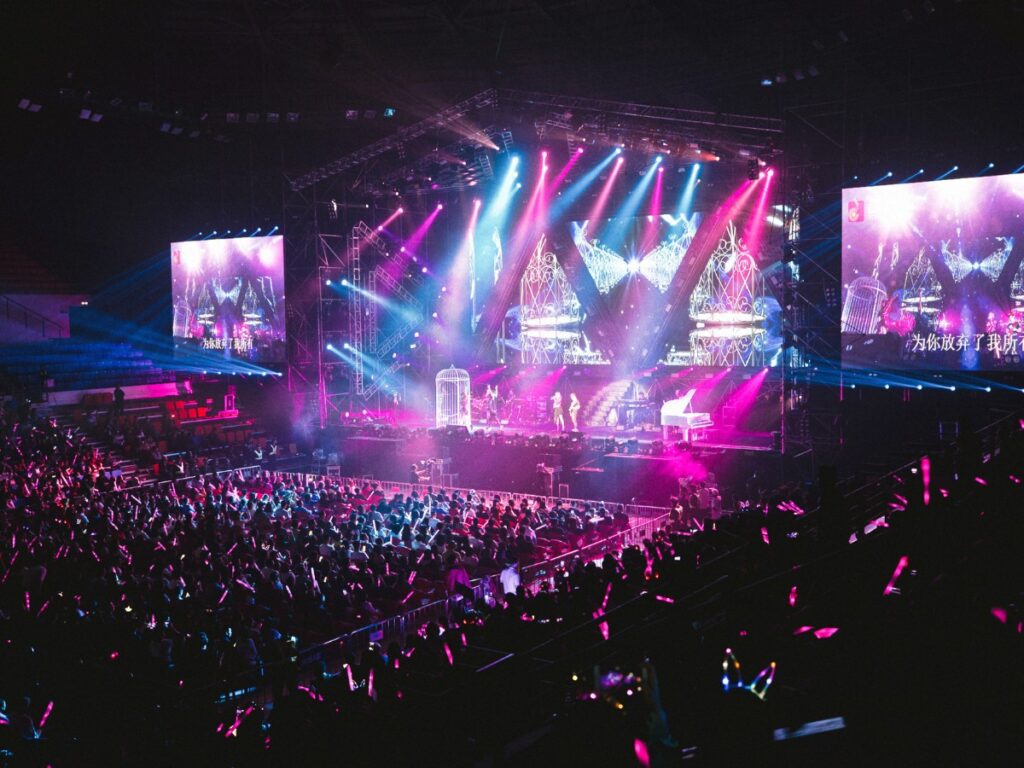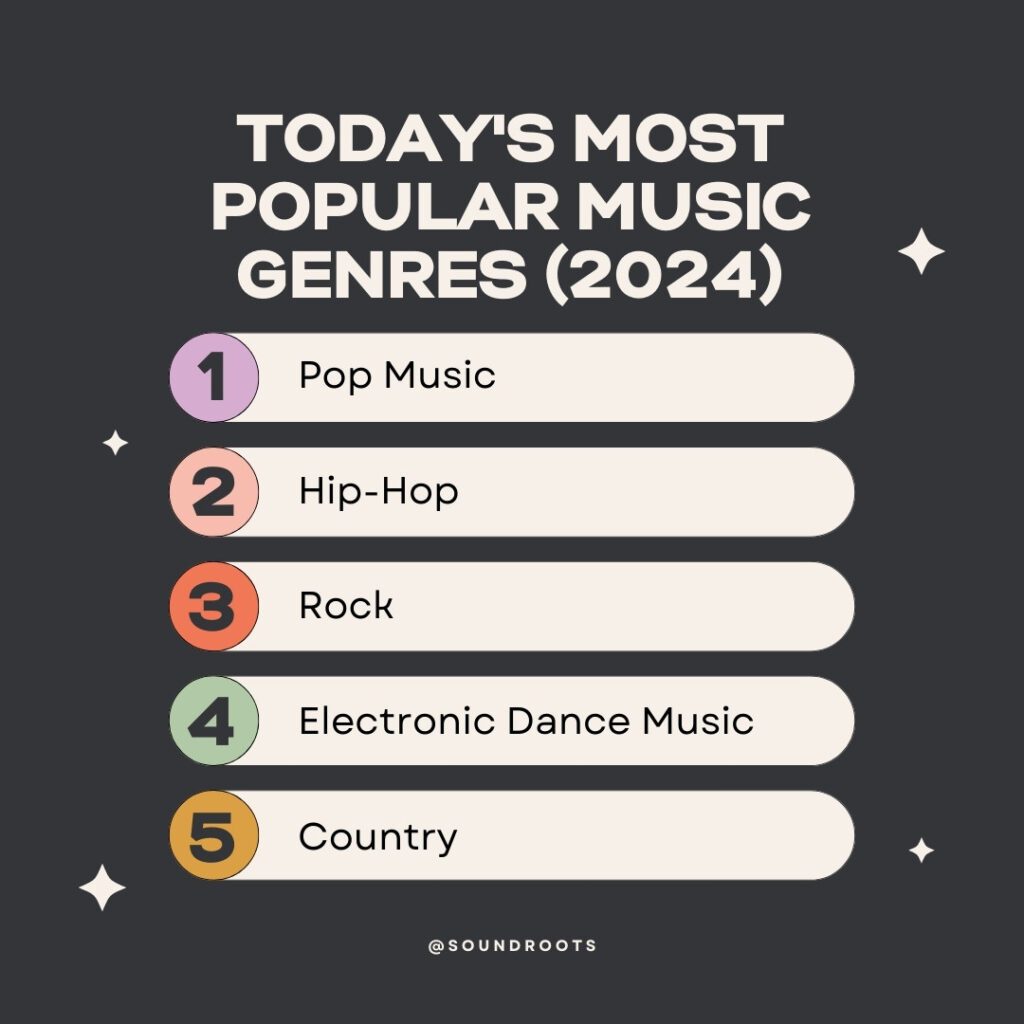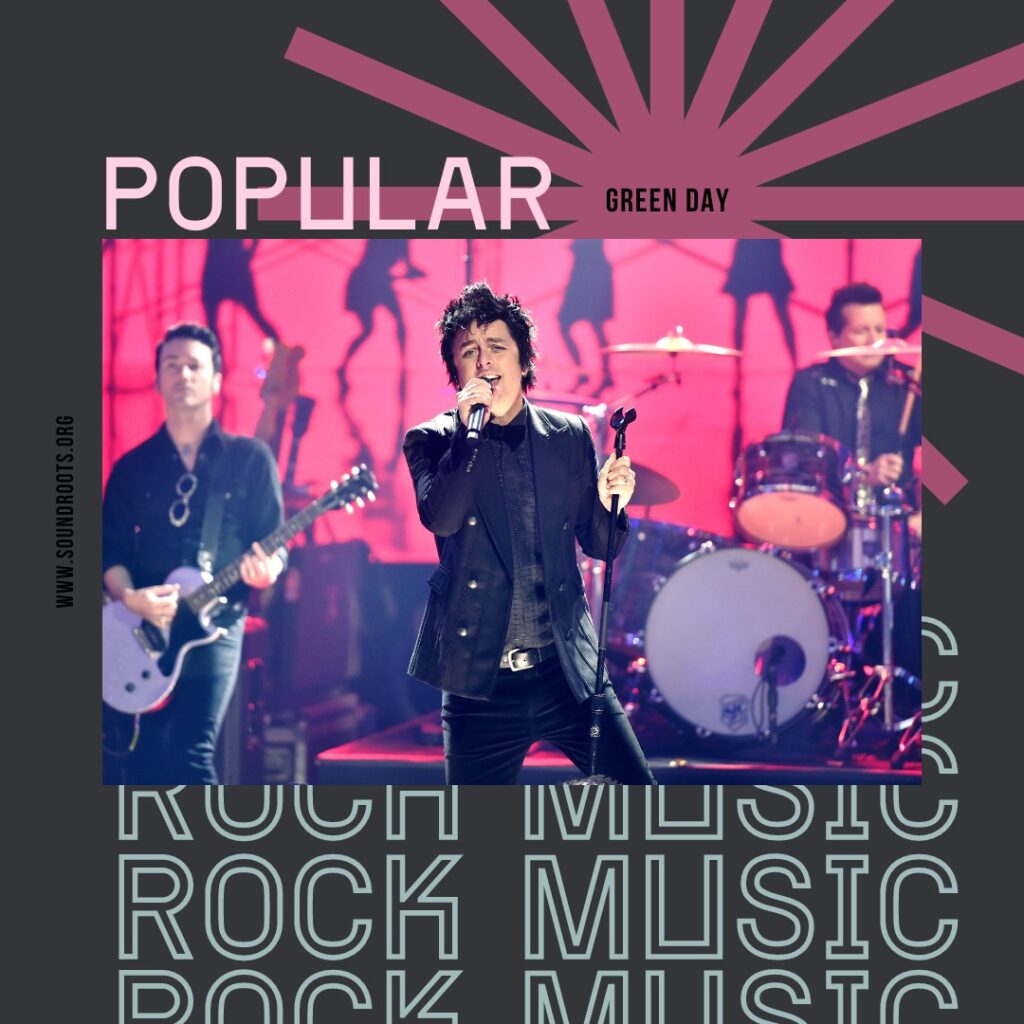In the times of endless streaming services and new music popping up by the minute, which genre comes out on top? Discover the most popular music genres of today with influential artists you need to know to understand the movement.

Music has always been a deeply significant part of human culture, dating back thousands of years. And as we’ve evolved, so have the most popular genres of the time.
From basic percussion instruments to the ultra-produced tracks of 2024, our ideas of music are constantly expanding. This makes way for new and exciting genres to emerge and fill voids we didn’t even know existed!
So, how many genres of music are there?
There are more genres of music in the world than you could ever count, with new sub-genres and classifications popping up by the minute.
Have you ever heard of Dungeon Synth? Folktronica? Dream Pop? Probably not.
And while these exciting new genres are definitely worth the listen, there’s nothing quite like the classics.
Today, we’re going to focus on the music genres most dominating the global music scene. We’ll explore some of the most popular music genres of the now, highlighting five of the most impactful genres in the industry.
The 5 Most Popular Music Genres Of 2024
These are the five most popular genres of music in North America that we’re going to be exploring:
- Pop Music
- Hip-hop
- Rock
- Electronic Dance Music
- Country
There are countless more beloved genres, particularly outside the focus of the Western World.
Think of every category at the Grammys – world music, reggae music, classical music, chamber music … this list is not a global perspective!
Still, each of these most popular styles of music has major global reach.

Pop Music – The Mainstream Powerhouse
What is the most popular music genre? Aptly named – pop music!
Pop has been a dominant force in the music industry for decades, maintaining its spot as one of the most popular music genres. In fact, it remains the single most popular genre in the mainstream scene.
The pop genre is characterized by its catchy melodies, simple lyrics, and relatable themes. Its accessibility and mass appeal have made it a staple on radio stations and music charts around the world.
Evolution of Pop Music
The genre has evolved significantly over the years, from the bubblegum pop of the 1960s to the synth-heavy pop of the 1980s and the electronic pop of the 2000s.
Pop music has also been influenced by other genres, such as R&B, hip-hop, and rock, which has led to the emergence of sub-genres like pop-rock and pop-R&B.
The evolution of technology has also played a significant role in shaping the sound of pop music. The use of synthesizers, auto-tune, and other production techniques have become commonplace in the genre.
Pop Influencers: Past to Present
Famous pop artists have had a significant impact on the music industry. Icons like Michael Jackson, Madonna, and Britney Spears have influenced generations of pop stars, while contemporary artists like Taylor Swift, Ariana Grande, and Justin Bieber continue to dominate the charts. These artists have not only defined the sound of pop music but have also become cultural phenomena, influencing fashion, dance, and even politics.
Producers and songwriters are using digital audio workstations, virtual instruments, and software plugins to create complex arrangements and manipulate vocal performances. The use of social media has also allowed artists to interact with fans and promote their music more effectively.
Despite the rise of other genres like hip-hop and electronic music, pop music continues to dominate the charts. Its mass appeal and ability to connect with listeners on an emotional level make it a timeless genre that will continue to be a powerhouse in the music industry.
Pop artists to know:

Hip-Hop – From the Streets to the Mainstream
One of the most popular music genres of our time, hip-hop emerged in the African American communities of the Bronx, New York City, in the 1970s. It is characterized by rapping, sampling, beatboxing, and DJing. The global popularity of hip-hop can be attributed to several factors, including its cultural significance, social relevance, and unique sound.
Cultural Impact of the Hip-Hop Genre
Hip-hop music has become more than just a genre; it has become a cultural movement. Its lyrics often focus on social and political issues, including poverty, racism, and police brutality. Artists find their way to express their experiences and give a voice to marginalized communities via hip-hop.
The use of sampled beats, electronic instrumentation, and syncopated rhythms is unparalleled, and many of the biggest artists in the world have been inspired by it, bringing hip-hop culture to a wider audience.
Hip-hop artists to know:
- Kendrick Lamar
- Nicki Minaj
- Doja Cat

Rock – The Timeless Classic
For over fifty years, rock music has been a strong influence in the music industry and continues to be a favorite genre today – and I’m not just talking classic rock.
The genre’s strong vocals, electrifying guitar riffs, and lively beats have captured the admiration of music lovers worldwide. The appeal of rock music spans across age groups and has influenced many artists and bands across different music styles.
Evolution of the Rock Genre
From rock and roll in the 1950s to heavy metal and grunge in the 1990s, rock music has changed drastically over the years. It started to be used as a platform for social and political criticism in the 1960s, with rock bands like The Beatles and The Rolling Stones.
Punk rock, new wave, and glam rock were among the sub-genres of rock music that were introduced during the 1970s, increasing its diversity. While alternative rock and grunge started in the 1990s, stadium rock originally became popular in the 1980s.
Rock music’s sound was defined in the 1970s by legends like Led Zeppelin, The Who, and Pink Floyd, while grunge was popularized in the 1990s by groups like Nirvana and Pearl Jam.
This music genre is still alive and being dominated by modern artists like Foo Fighters and Muse, with soft rock additions from Coldplay and The Killers.
Rock artists to know:
- Green Day
- Arctic Monkeys
- The 1975

Electronic – The Futuristic Sound
Electronic music is another of the most popular genres that has gained increasing popularity in recent years.
With its futuristic sound and innovative production techniques, it has become a leading power in the music industry. This genre is characterized by the use of electronic instruments, such as synthesizers and drum machines, to create a unique and futuristic sound.
Evolution of EDM
From the early days of experimental electronic music in the 1950s and 1960s through the emergence of electronic dance music (EDM) in the 2000s, electronic music has seen substantial development. Many sub-genres have also developed, including techno, house, trance, and dubstep.
Each subgenre has its own distinctive sound and fashion, and several of them have grown immensely popular all over the world.
One of the unique aspects of electronic music is the use of technology in its production.
Electronic music producers use a range of software, hardware, and digital tools to create their music. They often use digital audio workstations (DAWs) to record, edit, and mix their tracks. They use virtual instruments and effects plugins to create unique sounds and textures.
Modern EDM
Today, electronic music artists have access to cutting-edge, futuristic sounds that are not possible to make with traditional instruments.
Despite the popularity of electronic music, some critics argue that it lacks the authenticity and emotion of traditional music. Fans argue, however, that the genre’s futuristic sound and innovative production techniques are what make it so unique and exciting.
EDM artists to know:
- David Guetta
- Marshmello
- Calvin Harris

Country – The Sound of Americana
Country is one of the top music genres in the Western world, with deep American roots that resonate with its listeners.
The country music genre is characterized by the use of acoustic instruments like the guitar, fiddle, and banjo, along with lyrics that often depict rural and working-class life. With its distinctive sound and storytelling lyrics, country music has become an integral part of American culture.
Country music is often associated with values like family, hard work, and patriotism, resonating with many Americans.
The genre has a rich history and culture that continues to be celebrated through events like the Country Music Association Awards and the Country Music Hall of Fame.
Evolution of Country Music
This genre has evolved significantly over the years, from its roots in traditional folk music to the emergence of sub-genres like outlaw country and country pop. One of the most significant changes in country music over the years is the increasing crossover with other genres, such as rock, pop, and hip-hop. This has led to the rise of artists like Taylor Swift, who started as a country artist before transitioning to pop.
Famous country artists like Johnny Cash, Dolly Parton, and Garth Brooks have helped popularize country music both in the United States and around the world.
Despite some criticism that it has become too commercialized and lost its authenticity, it remains an important part of American values.
Country artists to know:
- Luke Combs
- Thomas Rhett
- Miranda Lambert

Bonus! Tik-Tok is creating a whole new music genre
TikTok is once again throwing a wrench into the scene, heavily influencing the most popular music genres of our generation.
Lovingly coined “internet music,” Tiktok has birthed so many genres from “post-lofi” to “Y2K revival,” to “bimbo-core.”
This is music for the people, by the people, with heavy influences from hip-hop, alt-rock, and dance-pop – you name it!
This is music for the people, by the people. And while older generations would love to shrink this music into a singular, unappreciated musical genre, TikTok is influencing pop culture worldwide.
What started as a mere social platform has transformed into a global trendmaker, deciding which genre of music is the next big thing.
Platforming new and creative artists from all around the world, our most popular music genres could be a thing of the past sooner than we know it.
Final Thoughts – The Most Popular Music Genres of 2024
Music has woven itself into the fabric of our daily lives, and its influence is undeniable. We now have a diverse range of popular music genres to choose from to suit our moods and preferences.
With continuous growth and transformation, the emergence of new genres, and the evolution of existing ones, there’s no telling what music will look like 100 years from now.
And though the popularity of different music genres may ebb and flow, one thing is certain – music will always be an essential part of our culture.




Leave a Reply